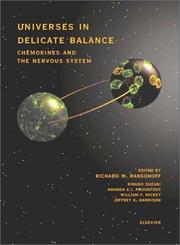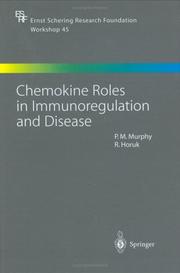| Listing 1 - 10 of 80 | << page >> |
Sort by
|
Book
Year: 2018 Publisher: Basel : MDPI - Multidisciplinary Digital Publishing Institute,
Abstract | Keywords | Export | Availability | Bookmark
 Loading...
Loading...Choose an application
- Reference Manager
- EndNote
- RefWorks (Direct export to RefWorks)
A hallmark of inflammation is the accumulation of leukocytes, which can serve to remove pathogens and necrotic tissue, but may also damage healthy tissue and exacerbate the inflammatory response. Our understanding of leukocyte recruitment in inflammation was revolutionized in the late 1980s by the discovery of chemokines (chemotactic cytokines), a family of small, secreted proteins that induce migration of selective subsets of leukocytes. Shortly afterwards, chemokines were found to exert their functions through the now familiar chemokine receptors, members of the G protein-coupled receptor superfamily. As their physiological and pathological functions were elucidated, chemokine receptors have become popular targets for drug development in inflammatory diseases as well as cancer metastasis and HIV infection. Extensive research has revealed that the functions of chemokines and their receptors are regulated at numerous levels, including: genetic mutations/polymorphisms; control of expression levels; ligand internalization via functional or decoy receptors; intrinsic selectivity of chemokine-receptor binding; hetero- or homo-oligomerization of chemokines or of receptors; alternative signalling pathways; interaction of chemokines with glycosaminoglycans; post-translational modifications; and binding to pathogen-derived inhibitors. This Special Issue of IJMS focused on the natural and pharmacological mechanisms by which the activities of chemokines and their receptors can be regulated.
Book
ISBN: 3736949847 Year: 2015 Publisher: Gottingen, [Germany] : Cuvillier Verlag,
Abstract | Keywords | Export | Availability | Bookmark
 Loading...
Loading...Choose an application
- Reference Manager
- EndNote
- RefWorks (Direct export to RefWorks)
Book
Year: 2018 Publisher: Basel : MDPI - Multidisciplinary Digital Publishing Institute,
Abstract | Keywords | Export | Availability | Bookmark
 Loading...
Loading...Choose an application
- Reference Manager
- EndNote
- RefWorks (Direct export to RefWorks)
A hallmark of inflammation is the accumulation of leukocytes, which can serve to remove pathogens and necrotic tissue, but may also damage healthy tissue and exacerbate the inflammatory response. Our understanding of leukocyte recruitment in inflammation was revolutionized in the late 1980s by the discovery of chemokines (chemotactic cytokines), a family of small, secreted proteins that induce migration of selective subsets of leukocytes. Shortly afterwards, chemokines were found to exert their functions through the now familiar chemokine receptors, members of the G protein-coupled receptor superfamily. As their physiological and pathological functions were elucidated, chemokine receptors have become popular targets for drug development in inflammatory diseases as well as cancer metastasis and HIV infection. Extensive research has revealed that the functions of chemokines and their receptors are regulated at numerous levels, including: genetic mutations/polymorphisms; control of expression levels; ligand internalization via functional or decoy receptors; intrinsic selectivity of chemokine-receptor binding; hetero- or homo-oligomerization of chemokines or of receptors; alternative signalling pathways; interaction of chemokines with glycosaminoglycans; post-translational modifications; and binding to pathogen-derived inhibitors. This Special Issue of IJMS focused on the natural and pharmacological mechanisms by which the activities of chemokines and their receptors can be regulated.
Book
ISBN: 0128021950 0128021713 Year: 2016 Publisher: Amsterdam, [Netherlands] : Academic Press,
Abstract | Keywords | Export | Availability | Bookmark
 Loading...
Loading...Choose an application
- Reference Manager
- EndNote
- RefWorks (Direct export to RefWorks)
Book
ISBN: 1803561742 Year: 2023 Publisher: London : IntechOpen,
Abstract | Keywords | Export | Availability | Bookmark
 Loading...
Loading...Choose an application
- Reference Manager
- EndNote
- RefWorks (Direct export to RefWorks)
This book provides an overview of some of the latest developments in the medical sciences, with particular emphasis on the experimental and theoretical aspects of modern medicine. In recent years, researchers working in applied health sciences have been able to identify diseases indicated by chemokines. Among the topics discussed in this book are chemokines affecting platelet functions, cytokine levels, and oxidative stress parameters in COVID-19, chemokines at the intersection of diabetes-tuberculosis synergy, chemokines in periodontal diseases, pathogenic links between hepato-digestive disorders and periodontal conditions, and IL-inflammatory carcinogenesis. Other areas included are the role of 23 receptor gene variations, the relationship between interleukin-5 Receptor polymorphism, and immunological parameters in children with asthma. The book's primary target audience includes students, researchers, medical practitioners, dentists, pharmacologists, and professionals interested in related fields. The book has been written by expert international scientists active in research in the health and applied sciences. We hope it will increase scientists' knowledge of the complexity of some medical approaches, and encourage both professionals and students to devote part of their future research to understanding the mechanisms and applications of chemokines.

ISBN: 9780444510020 0444510028 1423755472 9781423755470 0080520197 9780080520193 128102838X 9781281028389 9786611028381 Year: 2002 Publisher: Amsterdam ; New York : Elsevier,
Abstract | Keywords | Export | Availability | Bookmark
 Loading...
Loading...Choose an application
- Reference Manager
- EndNote
- RefWorks (Direct export to RefWorks)
It is commonly acknowledged that the nervous system and the immune system, those most complex of networks, share attributes beyond their intricacy. Elements common to the two systems include memory, connectivity, flexibility and developmental selection of cellular composition by a rigorous process involving widespread programmed cell death. There is one salient difference: the cells of the immune system are predominantly in constant motion, while post-mitotic neurons and glia are largely fixed in place. Therefore, chemokines, initially characterized as leukocyte chemoattractants, have for t

ISBN: 0121821889 9780121821883 Year: 1997 Volume: 287 Publisher: San Diego (Calif.) : Academic press,
Abstract | Keywords | Export | Availability | Bookmark
 Loading...
Loading...Choose an application
- Reference Manager
- EndNote
- RefWorks (Direct export to RefWorks)
Enzymology --- Chemokinen --- Chemokines --- Chimokines --- Inflammatory cytokines --- Chimiokines

ISBN: 3540402217 Year: 2004 Publisher: Berlin ; Heidelberg ; New York, NY : Springer-Verlag,
Abstract | Keywords | Export | Availability | Bookmark
 Loading...
Loading...Choose an application
- Reference Manager
- EndNote
- RefWorks (Direct export to RefWorks)
CHIMIOKINES --- FUCOSYLTRANSFERASES --- SELECTINS --- CHEMOKINES --- IMMUNOLOGY --- CONGRESSES
Book
ISBN: 030644710X 1461362830 1461529522 Year: 1993 Volume: 351 Publisher: New York Plenum Press
Abstract | Keywords | Export | Availability | Bookmark
 Loading...
Loading...Choose an application
- Reference Manager
- EndNote
- RefWorks (Direct export to RefWorks)
Chemokines --- Congresses --- Chemokines - Congresses. --- Chemotactic factors --- Chemotaxis, leukocyte --- Cytokines --- Inflammation --- Interleukin-8
Multi
ISBN: 293040423X Year: 2005 Publisher: Liège Université de Liège. Faculté de médecine vétérinaire
Abstract | Keywords | Export | Availability | Bookmark
 Loading...
Loading...Choose an application
- Reference Manager
- EndNote
- RefWorks (Direct export to RefWorks)
Chemokines --- Dna, viral --- Herpes viridae --- Varicellovirus --- Metabolism --- Chemistry
| Listing 1 - 10 of 80 | << page >> |
Sort by
|

 Search
Search Feedback
Feedback About UniCat
About UniCat  Help
Help News
News